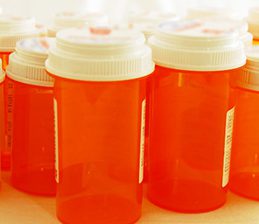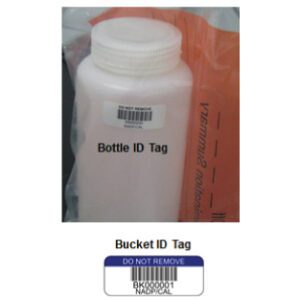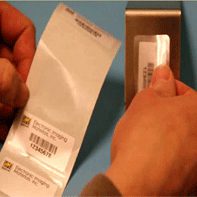SURFACE ENERGY
 A good way to understand surface energy is the example of waxed and un-waxed cars. Think about water dropping on an un-waxed engine hood―this is where the surface energy is high and the water flows into puddles. On a waxed hood, the surface energy is low and the water beads up instead of flowing out.
A good way to understand surface energy is the example of waxed and un-waxed cars. Think about water dropping on an un-waxed engine hood―this is where the surface energy is high and the water flows into puddles. On a waxed hood, the surface energy is low and the water beads up instead of flowing out.
Adhesives react in the same way so that when applied to plastics with high surface energy (HSE), the adhesive flows or “wets out” over the surface, providing a broader area for linking and sticking. This wetting out is an important factor in creating a good bond; the general theory is the higher the surface energy, the better the bond. Things made with strong, rugged HSE plastics hold up to long term abuse in automotive and appliance applications.
If you are trying to label a low surface energy (LSE) plastic, check to see if the surface has been primed, flame treated or corona treated to create higher surface energy. Otherwise, a special adhesive formula may be needed to get the best bond. The low cost and physical characteristics of LSE plastics such as durability, flexibility and resistance to heat, moisture and chemicals make them very popular. This is why lab containers can be a challenge to label―most are made with LSE polypropylene.
NOTE: Surface energy is measured in terms of Dynes/Cm. If you don’t know what type of plastic you are working with, try the water test. If you pour water on it and it beads up, then it is a LSE material.
- Examples of High Surface Energy (HSE) Plastics & Dyne Levels: Kapton (50), Nylon (46), Polyester (43), ABS (42), Polycarbonate (42), Rigid PVC (39), Acrylic (38)
- Examples of Low Surface Energy (LSE) Plastics: Polystyrene (36), Polyethylene (31), TPO (30), Polypropylene (29), Teflon (18)
SMOOTHNESS/ROUGHNESS
When designing a product the appearance may be a critical factor and thus the finish may be one of the first choices a manufacturer makes. Sleek, modern impressions lean towards glossy, smooth surfaces whereas higher quality may be associated with metal-like rougher textures.
Many times an aggressive adhesive can grab better to a rough texture than a smooth finish because it flows into the “hills and valleys” of the surface. However, if you are also dealing with surface energy issues, the adhesive has less opportunity to make surface contact and achieve the right bonding. Textured surfaces also require greater pressure, longer dwell times and thicker adhesives than what would be used on smooth items.
POROSITY
As plastics are transformed into flexible or solid products they go through either liquid/film extrusion or injection molding of granular or powdered plastics. During these processes, a certain amount of voids or trapped pockets of gas are created while curing.
Over time, when the plastic product is exposed to any form of heat or sunlight, the trapped air will expand and blow pinholes in the surface―a process called “out-gassing.” Manufacturers may impregnate the plastic to seal the voids with chemicals but then those chemicals can later emerge to create other problems. If you have ever used a plastic tote bin, you have probably struggled trying to find a label to stick to it because of out-gassing.
Often, manufacturers may use release agents to lubricate the surface of a mold and make parts ejection easier. Furthermore, the variations in plastic chemistries (especially in mixtures of recycled materials), coupling agents, fillers and binders that are added to reduce cost or improve physical characteristics, as well as hardeners that are used to improve curing all add to surface issues.
This is why the specific nature of those contaminants has to be considered to define the best possible adhesive to use; typical solutions involve special formulas with resin and/or rubber tackifiers as well as heavier adhesive coat weights.
FLEXIBILITY
Some plastics, such as vinyl (PVC), have plasticizers added to make them softer and more flexible. Like out-gassing, these plasticizers migrate to the surface and can degrade an adhesive’s bond. As plasticizers leach into and contaminate an adhesive, they often cause it to change color and become gummy or tacky. When defining the right label adhesive, we look for “plasticizer resistance.”
Plastics that can easily bend have good elasticity that allows them to quickly return their previous shape. There are some so flexible and conformable―like neoprene and polyurethane ―that they easily stretch so they are perfect for applications like hoses and gaskets. The more pliant the plastic, the harder it is to find labels for plastic and adhesive to flex and stretch with it.
 COATED or UNCOATED
COATED or UNCOATED
Some plastics may be specially coated to prevent contamination – for instance in food containers. Plastic eye glass lens offer different coating characteristics for reflecting glare and blocking UV light.
The most common coating for plastic however, is called a powder coating, a technique that reinforces and protects the plastic. This process makes the surface smooth or textured and can eliminate some porosity issues, but then that powder coating becomes the bonding surface rather than the plastic itself. Common applications for powder coating include appliances, automotive, office furniture, medical devices, electronics and other consumer goods.
Coated plastics add an extra element to consider in choosing the right adhesive. Uncoated plastics are generally not as complicated.
CLEANLINESS
Dirty surfaces of any kind can contaminate a label adhesive. Dirt and grime add to the complexity of plastic surfaces when trying to finding the right adhesive. Pre-cleaning a plastic surface generally only requires a mild detergent and water; using a nylon scrub brush may help on textured surfaces. For really tough dirt or grease, a kitchen spray cleaner or glass cleaner will work, but isopropyl alcohol is also a good choice and is a standard recommendation EIM makes before applying labels to any surface.
SIZE & SHAPE
Last but not least, the size and shape of a plastic item may have a good deal of bearing in choosing the right adhesive. Small surfaces require small labels with less “real estate” (surface) to adhere to, so a stronger, quick stick adhesive may be best suited. Larger labels give an adhesive a better chance to hold tight.
The overall shape of the plastic can also be a challenge. Curved surfaces like test tubes with tight circumferences generally require stronger adhesives than flat surfaces. Sharp angles or multiple curves add more complications.
So, from our two articles about labels for plastic―you can see there are a lot of things to consider:
1. What type of Plastic will you be labeling? See the SPI chart in our first article (This should then quickly determine the type of Surface Energy)
2. How Smooth (or Rough) is the Surface?
3. What can you tell us about the Construction and Porosity? Any out-gassing, fillers, binders, release agents, hardeners?
4. How Flexible is the plastic? This will help define how much plasticizer is used.
5. Is the plastic Coated or Uncoated?
6. How Clean is the plastic?
7. What is the Size and Shape of the item? What size label do you want and where will it be placed?
8. Do you have a sample of the plastic we could test before sending you samples?
As always, The Label Experts are here to guide you through the process of finding the right label material and adhesive for your plastic surface application. We will be sure to send you labels for plastic samples to test! Plastics can be complicated but we aim to make the labeling process as quick and simple as possible.


 COATED or UNCOATED
COATED or UNCOATED


